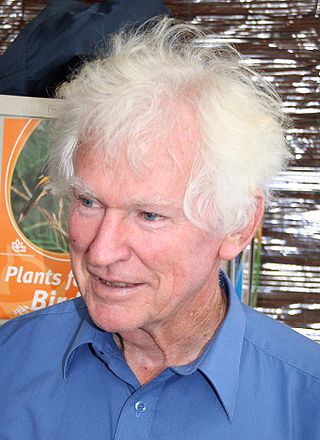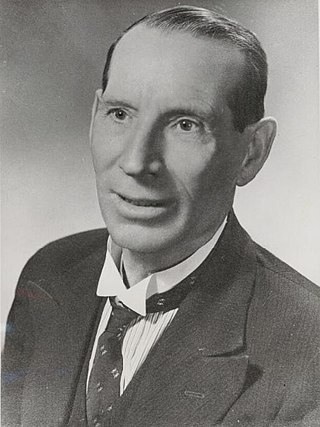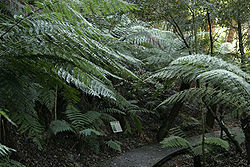
Royal Botanic Gardens Victoria are botanic gardens across two sites–Melbourne and Cranbourne.

Alexander Segger George is a Western Australian botanist. He is the authority on the plant genera Banksia and Dryandra. The "bizarre" Restionaceae genus Alexgeorgea was named in his honour in 1976.

The Australian Botanic Garden Mount Annan is a 416-hectare (1,030-acre) botanical garden located in a hilly area of the southwestern Sydney suburb of Mount Annan, between Campbelltown and Camden, New South Wales. It is the largest botanical garden in Australia, specializing in native plants, with a collection of over 4000 species. Officially opened in 1988, it was known as Mount Annan Botanic Garden, until 2011.

Banksia nutans, commonly known as nodding banksia, is a species of shrub native to the south coast of Western Australia in the genus Banksia. Growing to a metre (3 ft) tall, it has pale blue-green fine-leaved foliage and unusual purple-brown inflorescences which hang upside down rather than grow upright like most other banksias.

Nancy Tyson Burbidge was an Australian systemic botanist, conservationist and herbarium curator.
The Blatter Herbarium (BLAT), in St. Xavier's College, Mumbai, is a major Herbarium in India. It is listed in the Index Herbariorum, published by the International Association for Plant Taxonomy and New York Botanical Garden. The Herbarium specializes in the vascular plants of western India; algae, mosses, and fungi of Mumbai; seed samples of medicinally and economically important plants of Maharashtra, and wood samples of Maharashtra. The institute holds the largest botanical collection in western India.

Banksia epica is a shrub that grows on the south coast of Western Australia. A spreading bush with wedge-shaped serrated leaves and large creamy-yellow flower spikes, it grows up to 3½ metres (11½ ft) high. It is known only from two isolated populations in the remote southeast of the state, near the western edge of the Great Australian Bight. Both populations occur among coastal heath on cliff-top dunes of siliceous sand.
Lindsay Dixon Pryor AO was an Australian botanist noted for his work on Eucalyptus taxonomy and his role in the landscape design of Canberra, including the foundation of the Australian National Botanic Gardens.

Angophora hispida grows as a mallee, or as a tree to about 7 m (25 ft) in height. A. hispida's small size, especially when compared to its Angophora and Eucalyptus relatives, leads to it being known by the common name dwarf apple. It is native to a relatively small patch of central New South Wales – from just south of Sydney up to the Gosford area. The plant's leaves are sessile (stalk-less) and hug the stem with heart-shaped bases. Its previous name – A. cordifolia – referred to these cordate leaves. Another distinctive feature are the red bristly hairs that cover the branchlets, flower bases and new growth. This leads to the specific epithet hispida.

The National Herbarium of Victoria is one of Australia's earliest herbaria and the oldest scientific institution in Victoria. Its 1.5 million specimens of preserved plants, fungi and algae—collectively known as the State Botanical Collection of Victoria—comprise the largest herbarium collection in Australia and Oceania.

The flora of Australia comprises a vast assemblage of plant species estimated to over 30,000 vascular and 14,000 non-vascular plants, 250,000 species of fungi and over 3,000 lichens. The flora has strong affinities with the flora of Gondwana, and below the family level has a highly endemic angiosperm flora whose diversity was shaped by the effects of continental drift and climate change since the Cretaceous. Prominent features of the Australian flora are adaptations to aridity and fire which include scleromorphy and serotiny. These adaptations are common in species from the large and well-known families Proteaceae (Banksia), Myrtaceae, and Fabaceae.

Cordyline congesta, commonly known as narrow-leaved palm lily is an evergreen Australian plant. A rare shrub up to 3 metres tall found on the margins of rainforest, and in riverine scrub and moist gullies in eucalyptus forest. Growing north from the Clarence River, New South Wales.

William Faris Blakely was an Australian botanist and collector. From 1913 to 1940 he worked in the National Herbarium of New South Wales, working with Joseph Maiden on Eucalyptus, Maiden named a red gum in his honour, Eucalyptus blakelyi. His botanical work centred particularly on Acacias, Loranthaceae and Eucalypts.

Eucalyptus rhodantha, commonly known as rose mallee or rose gum, is a species of straggly mallee or shrub native to western parts of Western Australia. It has smooth bark and a crown composed entirely of circular to heart-shaped juvenile leaves arranged in opposite pairs and attached directly to the stems with no stalks. The flower buds appear singly in the leaf axils and are red, the fruits hemispherical to conical and pendent. The rose mallee is grown as an ornamental shrub suitable for gardens in hot and dry climates. It is found more often in urban gardens and cultivation than in the wild and is readily available in seed form.
Judith Gay West is an Australian scientist currently working as an Executive Director of the Australian National Botanic Gardens. West holds a doctor of philosophy (PhD) by thesis on "A taxonomic revision of Dodonaea (Sapindaceae) in Australia". She completed her PhD in 1981 from the University of Adelaide, South Australia.

The National Herbarium of New South Wales was established in 1853. The Herbarium has a collection of more than 1.4 million plant specimens, making it the second largest collection of pressed, dried plant specimens in Australia, including scientific and historically significant collections and samples of Australian flora gathered by Joseph Banks and Daniel Solander during the voyage of HMS Endeavour in 1770.
The Australasian Virtual Herbarium (AVH) is an online resource that allows access to plant specimen data held by various Australian and New Zealand herbaria. It is part of the Atlas of Living Australia (ALA), and was formed by the amalgamation of Australia's Virtual Herbarium and NZ Virtual Herbarium. As of 12 August 2014, more than five million specimens of the 8 million and upwards specimens available from participating institutions have been databased.

Patricia Holmgren is an American botanist. Holmgren's main botanical interests are the flora of the U.S. intermountain west and the genera Tiarella and Thlaspi. Holmgren was the director of the herbarium at the New York Botanical Garden from 1981–2000, and editor of Index Herbariorum from 1974–2008.

Council of Heads of Australasian Herbaria (CHAH) is an association of the leaders of herbaria in Australia and New Zealand. It is governed by a constitution. It endorses the taxonomy and nomenclature of the Australian Plant Census, which is the source for accepted names of species and, in particular, for accepted names of Australasian species. It supports the Australian Plant Name Index. CHAH is incorporated in the A.C.T. and is an Australian registered business with ABN 31 496 409 479.


















